 Michelle and I love the iPhone, and one of the best things about it is that there are many quality board games available to download for it. But with so many apps in the store, it can be difficult to find just what you’re looking for. So, here is a list of 5 great board games available from the iTunes App Store.
Michelle and I love the iPhone, and one of the best things about it is that there are many quality board games available to download for it. But with so many apps in the store, it can be difficult to find just what you’re looking for. So, here is a list of 5 great board games available from the iTunes App Store.
When picking these games, I only considered games that offer more than just a single player mode. While playing against an AI is fun, I personally enjoy playing against a live opponent much more. (And my wife and I have found that iPhone games are a great way to pass the time while we’re waiting for our food when we go out to eat :))
Hive
Hive is an interesting board game, in that it has no actual board! Instead, each player has an identical group of hexagonal tiles, each containing a picture of an insect. The idea is that each turn, a player either places a tile or moves a tile. Each insect moves in a different way, and an insect is not allowed to move in such a way that it would break up the hive into multiple pieces.
If you’ve ever played Tile Chess, this probably sounds familiar. However, unlike chess, there are no captures; insects are never removed from the hive once they are placed. A player wins when the opponent’s queen is surrounded on all six sides.
The iPhone version of this game is unique in that it is rendered in 3-D, so you are free to tilt and rotate the board to see the tiles from a different perspective. The controls are responsive, but the AI is not that difficult to beat. However, it’s still definitely worth checking out, especially if you’ll be playing as a two-player game.
Cost: $1.99
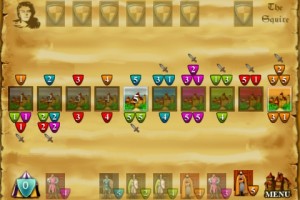 Knights of Charlemagne
Knights of Charlemagne
Knights of Charlemagne is a game by prolific game designer Reiner Knizia, who has designed many other popular games, including one our favorites, Lost Cities. In this game, players are battling over control of ten provinces. Five of the provinces are numbered from one to five, and the other five are associated with different colors: red, blue, green, orange, and purple.
Each player starts with a hand of eight tiles. Each tile is a “knight”, which is actually a number of a color. On each turn, a player places one of his knight tiles on a province that matches either the number or the color of the knight. Then, the player draws a tile to replace it. Players alternate turns until there are no more tiles left.
At the end of the game, each player scores points for the provinces in which they have more knights than the opponent. The numbered provinces are worth points equal to the number, and the colored provinces are each worth five.
This scoring system raises a question: why would anyone try to take one of the lower numbered provinces, if they are worth as much as the colored ones? Well, in typical Knizia fashion, there’s a catch that makes the low numbers worth more under certain circumstances. In this case, the player that controls the lowest two numbered provinces get the “crown”, which is worth an additional five point. So, if player A has provinces 2 and 4, but player B has provinces 1 and 3, player B gets five bonus points for having the two lowest provinces.
Knights of Charlemagne is presented simply on the iPhone, but it is a simple game by nature. The AI is a decent challenge, and good for getting familiar with the strategy of the game. Playing with two players is fun, but because it involves hidden information, it is a “pass and play” game, meaning that after each turn the screen darkens, and the next player presses OK to continue the turn. Some people may not like this feature, but it is the only way to play a game like this where you have tiles that are hidden from the other player. Overall, this is a fun, light game that plays very quickly.
Cost: $1.99
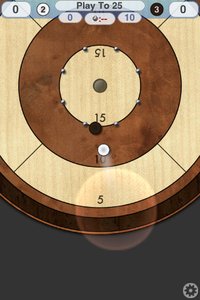 Croke
Croke
Croke is an iPhone adaptation of the popular dexterity game Crokinole.
In this game, players take turn flicking wooden discs toward the center of the circular board. The catch is that each turn, a player’s disc must strike at least one opponent’s disc, or it is removed from the board with no score. If there are no opposing discs on the board, then the disc must touch the center scoring area, or it is removed.
After each player has flicked eight stones onto the board, the players compare the number of points their discs are worth, and the player with the most points on the board scores the difference. Play continues either for a specified number of rounds, or when one player has scored a certain number of points.
It can be tough to design a quality video game version of a dexterity game. Either the controls are too sensitive and unpredictable, or they are so easy to use that a player can easily get a perfect shot every time. (Think about bowling video games where once you figured out how to get a strike, you could score over 200 almost every time.) However, Dot Matrix Interactive has done a wonderful job of integrating controls for the iPhone version that are intuitive, easy to use, but difficult to master. Croke is also a great two-player game, since there is no hidden info, and there’s very little waiting between turns.
Cost: $1.99
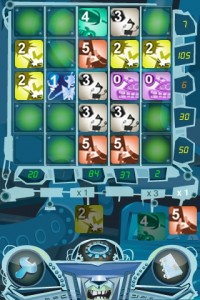 Robot Master
Robot Master
Like Knights of Charlemagne, Robot Master is another game designed by Reiner Knizia. (Can you tell we tend to like games he’s designed?) Being a Knizia title, this game also involves tiles and numbers (in this case, the numbers zero to five).
In Robot Master, the board is represented by a 5×5 grid. One player is assigned the rows of the grid, and the other one has the columns. One numbered tile is placed in the center of the board, and each player receives a set of tiles to form their “hand”. Like so many of Knizia’s games, a player’s turn consists of placing a tile on the grid, and then drawing a new one. Play continues until every square is filled.
At the end of the game, the value of each row and column is calculated by adding up the numbers in the row. Each player’s score is the total for the lowest scoring row or column. Because of this, player are required to spread their attention to the entire board, instead of focusing on getting a single high-scoring row or column.
The scoring itself is where this gets interesting. While the base score is calculated by simply adding the numbers together, there are (as we have come to expect) a couple of twists:
– If a row or column contains two tiles with the same number, then the pair is worth ten times that number. So for example, two “2’s” count for twenty points, and two “5’s” count for fifty.
– If a row or column contains three tiles with the same number, then that triplet is worth a hundred points, regardless of the number. So, while two “1’s” would only be worth ten points total, three “1’s” would be a hundred. This is also the only way zeroes can contribute any value to the row or column.
As with Knights of Charlemagne, this is a pass and play game, since each player keeps their tiles hidden. It’s another quick iPhone game with intuitive controls, and more depth than you would expect just from looking at the rules. And what’s better is that this one just costs a dollar!
Cost: $0.99
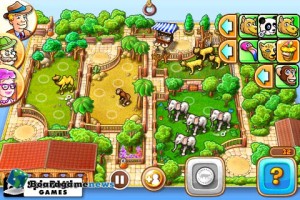 Zooloretto
Zooloretto
Zooloretto is probably the most complex of the games we’ve presented here today, although it is still pretty simple compared to some of the other board games that are out there. In this game, each player is the manager of a zoo who is trying to attract as many visitors as possible. Players attract visitors by collecting animals to put in their zoo and putting up stands for vendors near the various animals pens. The challenge comes from the fact that players can’t always predict what types of animals they will get, and getting too many different types can actually cost them visitors!
On his or her turn, each player has several options available to them. The first option is to draw a tile from the stack and place it on a truck. There is one truck for each player in the game, and each truck can hold up to three tiles. Each tile shows either an animal, a vendor stand, or a coin.
Instead of drawing a tile, a player may take a truck and add it to his or her zoo. Coins are added to the player’s bank. Vendor stands go in special spaces marked next to the player’s animal pens. Animals are placed in the pens. Players get points based on how full each of their pens are so it’s best to make sure the animals are arranged in such a way that they are all full (or almost full). A pen may not contain multiple types of animals though, so it is possible that a player can’t place some of the tiles. In this case, the tiles end up in the “barn”, where they will generally subtract from the player’s score at the end of the game.
As a third option, a player may take a coin action. I won’t go into the details of all the possible actions here, but they include things like building an extra animal pen, selling animals in the barn, buying animals from other players’ barns, and moving animals between pens. These actions give players a little extra control over the contents of the zoo, rather than relying on the randomness of the tiles.
Once all of the trucks have been taken, they are replaced and a new round begins. The game ends when almost all of the tiles are gone from the stack, and whoever has the most points win.
So you can see that this is more complicated than the other games I’ve mentioned, but it is also much deeper. The interface is intuitive, and since there is no hidden information in this game, you don’t have to pass and play it; you can see what your opponent is doing at all times. The only possible downside is that this is actually a game for three to five players, so unless you have at least three humans playing, you will have at least one AI player. However, the AI for this game is actually quite good, so overall this game is a huge win. Unfortunately, it does cost a bit more than the others, but I still feel that you get your money’s worth with this game.
Cost: $4.99
As I find more great iPhone board games, I’ll be sure to post them. In the meantime, what do you all think? Have you found any well done games for the iPhone that I’ve failed to mention? Please let us know about them in the comments below!
Like what you see? Let everyone know using the "Share/Save" button!
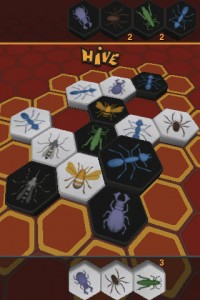

Don’t forget Knizia’s Ingenious, which is a lot of fun on the iPhone, even if the presentation and UI could use more polish.
While it takes a bit more time to play than the games mentioned above, I think it is worth noting that Settlers of Catan is on the iPhone.
Generally “multiplayer” when talking about digital games insinuates that there is online connectivity. Do any of these have online play?
That’s a great point; I probably should have clarified that in the post.
Croke is the only one that offers full online play, but it has been out a little while, so it can be hard to find opponents.
Hive offers multiplayer over a peer-to-peer network. The others are only multiplayer using the same iPhone.
Does anyone else remember the days when it was cool to just have a cell phone?? Iphones are really amazing!
I love Hive! It’s a really fun game that is definitely worth the download.
We Doodle is a lot of fun to play with friends, certainly on iPad. I suggest everyone to check it out, and pay 4 Euros if you like it and want to remove the ads… Cheers!I also want to say that the game I play 2-3 times a day is Zynga Poker which is also online multiplayer.
I have recently been doing a history and review of board games and have found Angry Birds: Knock on Wood which is a physical game for children and adults. Check it out on my blog http://www.squidoo.com/board-games-card-games-new-and-old
Playstation has always been the best way of rejuvenation, especially when you had nothing to do or the day was stressful. Be it racing, boxing, or adventure, I play all sort of games on my playstation. I think the new controller from Sony is worth buying. Thanks for sharing information about different products, which I was unaware of.
Hive and Robo Master are one of my favs besides Roll333s. I love my iPhone because of the amazing games available on App Store. I agree that people my find it difficult to filter out the best of games available and thanks for talking about the hot favorite games in detail.
Sweet! I just picked up an iphone since everyone in my family has one. Now, we’ll be able to play games against each other. Thanks for the list!